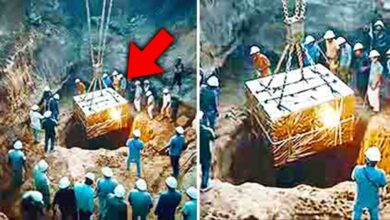Scientists Finally Discovered What’s Really Lurking Deep Under Oak Island
Scientists Finally Discovered What's Really Lurking Deep Under Oak Island

Well, I was excited before about the pottery, but I mean, pipe stems and maybe even a coin or something, looking for in Aladdin’s cave. We’re looking for some evidence that human beings were inside. It might have significant importance to what the island is trying to tell us. A game changer if it could be verified.
There should be no metal in a solution feature. 170 ft down in a flooded pitch black cavern, a diver’s metal detector screams to life. It’s not hitting a coin or a nail. It’s signaling a massive metallic object, something too big to be natural and too deep to be an accident.
This single moment is the culmination of centuries of searching on Oak Island. For years, the legend of a buried treasure has driven people crazy. But what scientists are now discovering is that the real story is far stranger and more complex than buried pirate loot. The truth is finally coming to light.
Clues on the seabed. For more than 200 years, the mystery of Oak Island has been a magnet for dreamers, engineers, and adventurers. But now, science is taking the lead. The focus has shifted to a murky, foreboding corner of the island, the swamp.
You see, many people are crazy about the money pit. But what many overlooked is that the swamp itself might be an artificial creation, a key piece of the puzzle. A team led by Alex Lagginina and diving expert Tony Samson is investigating the waters just off the northern shore of this swamp.
The reason: an ancient map provided by researcher Zena Halpern hinted at a man-made dam or structure right here. “We have evidence from Zena’s map that there’s a dam somewhere along the edge of the water. A structure that could have been used to flood the area and create the swamp in the first place.”
The water here is deceptively shallow, only seven to eight feet deep near the shore before it drops off to 25 feet. The most shocking fact is that hundreds of years ago, sea levels were much lower. This means this entire area could have once been dry land, a perfect place to build a structure.
The team isn’t just guessing. They’re armed with an ROV, a remote operated vehicle, giving them a second set of eyes beneath the waves. As Tony Samson descends into the cold Atlantic water, the team above watches his every move, hoping for a sign, any sign that they’re on the right track.
The mission is tricky. Provincial regulations are strict. They can look and they can scan with a metal detector, but they cannot dig or remove a single thing without a special permit.
Almost immediately, Tony’s voice crackles over the comms. “He’s found something. Not treasure, but something just as important: pieces of old hand-carved timber buried in the seabed. One piece is about a foot long, looking like a piece of planking. It’s not definitive proof, but it’s a start. It shows that man-made objects are indeed here, preserved in the cold water.”
But then, as he moves closer to a large boulder, things get even more interesting. Lying in the silt is a piece of pottery with a distinct blue marking. “Looks actually like pottery down here with blue markings.”
This is a massive wow factor because it’s eerily similar to pottery recently found on Lot 5—artifacts that could date back to the 1600s.
The thing nobody tells you is how these artifacts get concentrated in one place. One theory is that they washed ashore from a shipwreck, but another, more tantalizing theory is that this was a place of activity, a work site.
And then the discovery that changes the game: as Tony carefully scans around the boulder, he finds more than just pottery. He uncovers a clay pipe stem, a common find from the 17th and 18th centuries. But then his metal detector goes off.
There, half buried in the silt, is a small metallic disc with a hole in the center. It looks like a coin. Up on the boat, the team is stunned. Jack Begley immediately makes a connection: just up the hill from this very spot, he and Gary Drayton found an actual Chinese coin, one that was dated to be over a thousand years old. Could this be another one?
A coin of that age has no business being on Oak Island. Its presence suggests a history far older and more mysterious than pirates.
The team now faces a dilemma. They may have found a crucial clue, a direct link to an ancient presence on the island, but it has to stay on the ocean floor until the government grants them permission to retrieve it. To put it mildly, the frustration is immense—but so is the excitement.
They haven’t found a treasure chest, but they may have just found the key to understanding who was on Oak Island and why they built the swamp. What they found proves this area needs a much closer look.
The ultimate underwater treasure. While one team probes the secrets of the swamp, the heart of the operation beats in the money pit area at a place known as the Garden Shaft. This isn’t just a hole in the ground. It’s a historic shaft dating back to the mid-1800s, and it might just be the team’s best shot at finally reaching the treasure.
Brothers Rick and Marty Lagginina are gearing up to descend into the shaft for the first time this year. The goal is simple but incredibly dangerous: extend this 82 ft deep shaft down to nearly 100 ft.
Why that depth? Because strategic core drilling has revealed something incredible down there: a mysterious 7-foot-high tunnel. The most shocking fact is that carbon dating of wood from this tunnel places its construction as early as the 1600s—a full century before the money pit was even discovered.
This tunnel runs directly towards an area the team calls the Baby Blob, a spot where groundwater tests have shown unbelievably high concentrations of gold and silver.
But Oak Island doesn’t give up its secrets easily. As the brothers descend, the problem becomes terrifyingly clear: water is pouring into the shaft. Not a trickle, but a deluge coming from a specific point about 60 ft down. For 200 years, water has been the curse of Oak Island, the booby trap that has defeated every searcher.
Now, the team is facing it head-on. The pressure at this depth is immense, and the flow is relentless. They want to use a fast-setting urethane. They’re going to grout it and try to stop the water.
The experts from Duma Contracting have a plan to drill holes into the shaft wall and inject a specialized fast-setting urethane foam. This expanding compound will hopefully push into the surrounding rock and soil and seal off the flood.
As Rick and Marty reach the bottom, standing on a platform 87 ft below the surface, the significance of their location is overwhelming. Just a few feet below them is undisturbed Earth—ground that no human has seen in centuries. They are on the doorstep of the mysterious tunnel.
This shaft is more than just a path to potential gold and silver. It’s a gateway to understanding the incredible engineering of the original depositors. A horizontal tunnel at this depth pointing towards a concentration of precious metals is not an accident. It’s evidence of a sophisticated, large-scale operation.
What many overlooked is that the original builders weren’t just digging a pit—they were creating an underground complex.
The team’s plan is twofold: first, reach the tunnel; second, once inside, use a probe drill to search up to 40 ft in every direction, essentially creating a 3D map of the chamber and any valuables it contains. If the old tunnel is blocked, they will simply build a new one. It’s a battle of modern technology versus an ancient, ingenious foe.
The chamber and the block. The search on Oak Island is happening on multiple fronts, pushing the boundaries of technology and belief. 60 ft away from the Garden Shaft, another team is exploring an even deeper and more bizarre anomaly. It’s a borehole known as KL14.5, and it’s targeted directly at the center of a massive underground cavity the team has ominously named Aladdin’s Cave.
The shocking data from drilling showed an open space, a void, an incredible 10 ft high, nearly 150 ft below the surface. This is completely unnatural. You can see this everywhere on the island. Geology can’t explain these features. The only other explanation is that it was man-made.
The team is lowering a high-definition camera into the borehole, hoping to see the one thing that will prove their theory: evidence of human intervention. As the camera descends, the tension is unbearable. It passes the 140-foot mark and enters the cave.
The view is murky, filled with silt and sediment that seems to be moved by a current—a current 150 ft underground. It’s another baffling detail. And then, through the haze, the camera catches something. It’s hard to make out, but it looks like a square shape, almost like the head of a bolt or a spike. It’s not definitive, but it’s a tantalizing clue that human beings were once inside this deep, dark chamber.
We’re all hoping to see some evidence that men actually excavated this cave. For the team, this is all the proof they need to take the next step: deploying sonar equipment to map the cavern’s true size and shape, looking for other tunnels, or just maybe a treasure vault.
This isn’t just a cave. It’s a potential treasure location. But the island has one more even deeper secret to reveal. Further away, another operation is underway at a shaft called C1. Here, previous video footage captured a strange gold-colored object shimmering in the dark, located inside a cavity a mind-boggling 170 ft down.
Now, diver Mike Huntley is making the perilous descent to investigate it in person. This is one of the deepest dives ever conducted on the island. As he enters the cavity, his voice comes over the radio, calm and professional, but the message he delivers sends a jolt through the entire team.
His underwater metal detector is going wild. He’s getting powerful, consistent hits. The thing is, this type of cavity, known as a solution feature, or car geology, should be nothing but natural rock. There should be absolutely no metal here.
Mike’s discovery is a game-changer. It strongly suggests the cavity is not natural at all. He extends the detector away from his own gear to ensure it’s not a false reading. The signal is still there, screaming. He reports that the source is straight in front of him inside a pile of rubble on the cavern floor.
He tries to reach for it to feel what’s there. He describes the object as rock solid, smooth, and rounded. He can’t move it. It’s not a small artifact. He calls it a block—a massive metallic block 170 ft underground.
Is this the strange gold-colored object from the video? And what on earth could it be? The team is left with an incredible, maddening puzzle. They have located a huge metallic anomaly deep in the earth, a place it has no right to be. They are so close, yet the object remains just out of reach.
What it all means. So, what does all this mean? We’ve seen a potential ancient dam, pottery, and a mysterious Chinese-style coin on the seafloor. We’ve descended into the Garden Shaft, a 100-foot deep gateway to a tunnel filled with gold and silver signatures, guarded by a relentless flood of water.
We’ve peered into Aladdin’s Cave, a massive void 150 ft down with hints of man-made objects. And we’ve tagged along on a dive to an incredible depth of 170 ft, where a detector screamed over a massive immovable metal block.
Many people are crazy about finding a single treasure chest, but the evidence now points to something far grander, more complex, and frankly more important.
Let’s talk down to earth for a minute. The people watching this are looking for a mystery. And for two centuries, the mystery has been framed as a hunt for pirate treasure. But pirates didn’t build complex flood tunnels. They didn’t dig shafts over 100 ft deep and construct elaborate underground drainage systems, and they certainly didn’t possess thousand-year-old Chinese coins.
The thing nobody tells you is that the pirate story might have been the perfect cover for something else entirely. The sheer scale of the engineering on Oak Island—from the swamp to the money pit—suggests a massive, well-funded, and highly organized operation. The science is beginning to confirm this.
Are we missing a key detail? The thing is, the answer might not be a what, but a who and a why. Who had the knowledge and resources to build this in the 1600s or even earlier? Templar knights hiding a sacred relic? Francis Bacon’s circle concealing secret manuscripts? Or a group so secret we don’t even know their name?
The discovery of valuable metals like gold and silver is compelling, but it might just be a small part of the story. The real treasure could be the truth of who was here and the secrets they were so desperate to protect.
All of these recent discoveries aren’t just random finds. They are puzzle pieces. The pottery, the wood, the coin, the tunnels, the caverns—they are all interconnected parts of a colossal centuries-old machine.
The mystery isn’t just about what’s at the bottom. The mystery is the island itself. The evidence is overwhelming, but the final truth remains just out of reach.
What do you think is really buried under Oak Island? Is it a treasure, a sacred relic, or proof of a secret history they don’t want us to know? Let us know in the comments. And don’t forget to like and subscribe for more answers to the world’s greatest mysteries.








